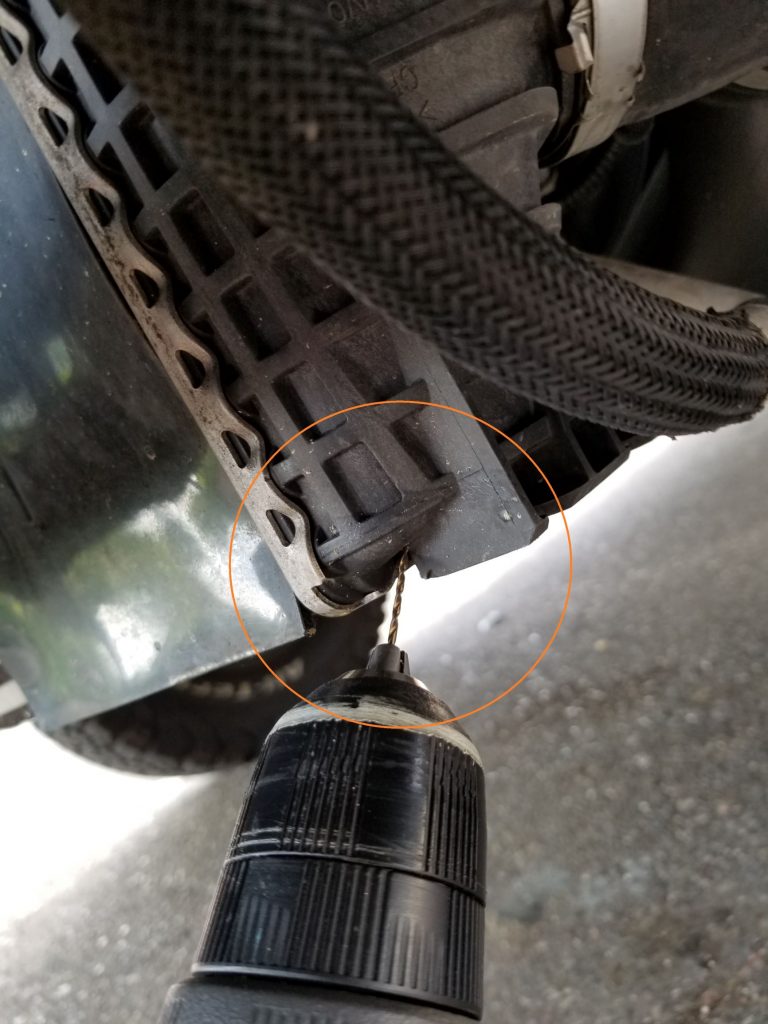It’s so satisfying when you fix something yourself, isn’t it? Especially if it saves you $265!
Here’s the story of how we fixed a common problem with our Ford EcoBoost engine. We replaced the spark plugs on our 2015 Ford Transit 250 Ecoboost 3.5L V6 twin-turbo engine (whom we named Alevander the Great).
If we could do it, you can too!

Ford Transit EcoBoost Hesitates on Acceleration
After several days of long-distance travel in our 2015 Ford Transit 250 EcoBoost, we noticed that our van started hiccupping under acceleration. It would do a little shudder if we hit the gas pedal too hard going uphill, and sometimes the check engine light would come on. Ruh-roh!
When a general mechanic could not find anything wrong (I guess Alevander was shy), we took to Google. We discovered that this hiccupping, or misfiring, is a common problem with Ford’s 3.5L V6 twin-turbo engine – AKA the EcoBoost. The EcoBoost is used in at least a couple models, like the Ford Transit van and the F-150 pickup truck.
The local Ford dealership said they could fix the problem for $350. After some deliberation, we decided, “Thanks for the free air-conditioning, coffee, and wifi, but we’ll try this repair ourselves first!”
The Cause: The Ford Transit “EcoBoost Shudder”
Here’s a quick (oversimplified) rundown of the problem with Ford’s EcoBoost, AKA the “EcoBoost” shudder.
The boost in EcoBoost refers to the engine’s turbochargers, or turbos. Turbos are little fans that blow air in the engine’s cylinders.
When you accelerate, the turbos blow air and gasoline gets ignited, all in the engine’s cylinder, or combustion chamber. More air + more gasoline = more power. You want lots of power if your vehicle is overloaded with thousands of pounds of home furniture and supplies – like ours is.
Here’s the catch: the air from the turbos also creates pressure inside the cylinder. This pressure forces stuff out of the cylinder, like oil and other gunk. This rejected oil seeps out of the cylinder and works its way through the rest of the engine. Eventually, the oil ends up on the spark plugs.
When your spark plugs have been dirtied with oil for too long, it means the spark plugs are “fouled.” Fouled spark plugs don’t work too well. With fouled spark plugs, spark plugs are more likely to misfire, which causes the hiccup under acceleration. The Ford mechanic showed us our dirty spark plugs to prove it.
Fixing the EcoBoost Shudder on Ford’s 3.5L Twin Turbo V6 Engine
To resolve your EcoBoost shudder, you have to
-
-
- Address the symptom (fouled spark plugs)
- Address the cause (oil blowby being sucked into the combustion chamber)
-
We suggest doing these steps in reverse. Why? If your vehicle isn’t too old, the spark plugs may not be too fouled yet. Step 1 may resolve your problem entirely, and you can skip installing new spark plugs. That will save even more money!
If your vehicle is older or has a lot of miles, Step 1 by itself may not resolve the shuddering problem.
In that case, your two-step solution is:
-
- To prevent the issue from recurring, or getting worse, you need to give the oil another place to seep – away from the spark plugs.
- To fix the damage already done, you need to replace the old spark plugs.
Step 1: Cleaning out the Dirty Oil
A quick recap of the problem: a design flaw in the EcoBoost causes oil and other gunk to “foul” the spark plugs. This means the spark plugs don’t work the way they are supposed. Spark plugs not working causes the vehicle to hiccup under acceleration.
So, to prevent this from happening, we need to create an escape route for that oil and gunk. This will prevent damage to the spark plugs.
There are two ways to do this:
A. Drill a Hole in the Charge Air Intercooler (CAC) of Your Ford Transit EcoBoost
This is the quicker and easier fix. You only need a small drill bit and something to lay on the floor for the gunk to drip on to.
Drill a tiny hole into the plastic end cap of the vehicle’s charge air cooler (CAC), also referred to as the intercooler. This is also referred to on the internets as a “weep hole.” The hole should be tiny enough for the oil gunk to escape, before it has a chance to work its way to the spark plugs.
We used a 1/16” drill bit to drill a small hole into the plastic end cap of the CAC.
After drilling, let the vehicle idle for a bit so the built-up gunk seeps out. Future gunk will seep out at such a slow rate that you shouldn’t see any drippings.
Remember, this is the small bit of engine oil that is already where it isn’t supposed to be. Letting this little bit of dirty oil escape won’t damage your vehicle. Instead will prevent future issues.

B. Install a “Catch Can”
The more complicated and costly way to resolve this problem is to install a “catch can.” A catch can is designed to capture any misplaced oil before that oil has a chance to work its way into the engine’s cylinders and foul the spark plugs.
You can purchase an after-market kit specifically for the Ford Transit Ecoboost here. This is purely an example; we have no experience with this catch can or any others. This is not an endorsement for the catch can.
This particular example runs at $570 just for the catch can – installation not included! In a perfect world, a catch can would be fantastic. But then again, in a perfect world, the Ford Ecoboost wouldn’t have this problem ;-D

Step 2: Replacing the Spark Plugs on your Ford EcoBoost
If Step 1 didn’t resolve the problem, move on to Step 2. You may also want to have a professional opinion on whether your spark plugs need replacing, before spending your time and money to do it.
It was clear to us that our spark plugs were damaged. So, here’s what we did to replace the spark plugs on our Ford Transit 250 Ecoboost:
A. Purchase your materials and supplies.
-
-
- Spark plugs (6) – Buy the appropriate spark plugs for your vehicle. If they aren’t pre-gapped to around .28 to .30, then you will also need to purchase a spark plug gap gauge to gap the spark plugs yourself. The gap gauge looks like a poker chip.
- Spark plug boots (6) – These are little rubber grommets that go over the ignition coils, separating the spark plugs from the ignition coils.
- Anti-seize – Most automotive stores sell tiny packets of anti-seize. One small packet is all you’ll need.
- Spark plug socket (5/8 inch) – Spark plug sockets have a special little rubber gasket or magnet to better grip the spark plug (see the picture of ours below). (A magnetic spark plug socket is also handy, but they do cost more.) We highly recommend having a swivel feature on your spark plug socket, which prevents damage during removal and installation by allowing the socket to move with the ratchet. You can either purchase a socket with swivel attached, or build the swivel feature yourself with a universal joint and an extension.
- Socket (8mm) – Your everyday socket. Optional: put your socket on a rachet, to make your life easier
- Torque wrench – We torqued (tightened) the spark plugs to 11 foot-pounds.
- Optional: Breaker bar – Jon used a breaker bar to give him more leverage to loosen the old spark plugs, since they were stuck so tightly. He attached the breaker bar to the spark plug socket, like he would a ratchet. After loosening the spark plug in the cylinder, he’d switch over to the ratchet to finish removing the old spark plug.
-
The folks any auto parts store should help you find the exact products and sizes to match our vehicle year, make and model. For us, the total came out to $85, after a $10 coupon for signing up online.
Bonus efficiency tip: Don’t want spam in your inbox? Make a separate spam email account specifically for signing up for coupons, discounts, etc. Google lets you switch between email accounts easily.

B. Park your vehicle and let the engine cool before starting.
When it comes to replacing the spark plugs on Ford’s EcoBoost engine, temperature is key. You need to Goldilocks it. You want the engine warm, not hot. If the engine is too hot, you’ll risk injury to yourself. If the engine is too cold, you might damage the threads of the engine cylinder. Neither situation is good.
We had been driving for quite some time before we started our project of replacing the plugs. Because it was such a hot day, we set up our 12V fans pointed over the engine and waited an hour for the cooling process.
C. Prepare your new spark plugs for installation on the Ford EcoBoost engine
If you didn’t get pre-gapped spark plugs, now is the time to gap them to the manufacturer’s specifications (around 28-thousands or 30-thousands for Ford’s EcoBoost engine).
Next, apply a healthy amount of anti-seize to the bottom threads of each spark plug – about fingerprint size.
D. Changing out the spark plugs on Ford’s EcoBoost to fix the EcoBoost Shudder.
I suggest doing one spark plug at a time. This keeps the process simple and decreases the chance you’ll misplace something. Also, replacing the spark plugs one at a time exposes your engine’s combustion cylinders to the elements and debris for the least amount of time.
We’ll briefly discuss the steps here, but for a visual aid, we’ve included below the most useful videos we found. Note: Since the Ford F-150 EcoBoost has the same engine as our Ford Transit EcoBoost, the steps for replacing spark plugs are nearly identical.
-
- Remove the foam insulating cover over the high-pressure pump towards the back of the engine.
- It is recommended to use an air compressor to blow away debris on the engine that could end up in the ignition coils. We didn’t have one available, so we skipped this step.
- Disconnect the connectors to the ignition coils (without breaking them!). To do this, first, slide the red plastic tab down. Then, press down the grey plastic clip. With a bit of elbow grease, you should now be able to slide the connector off. Jon used a screwdriver to make this a little easier on his fingers.
Reminder: here’s where we recommend working one spark plug at a time.
-
- Use the 8mm socket to remove the single bolt holding down the ignition coil.
- Remove the ignition coil, to which *should be* attached the old spark plug boot. If the old boot doesn’t come out with the ignition coil, have no fear! Read the section below for troubleshooting.
Bonus efficiency tip: if you have two people working on this, one person can jump to step #9 below while the other works on steps #6-8.
-
- Carefully use the spark plug socket to remove the old spark plug. Those spark plugs are in there tight! If you need a little more leverage to loosen the spark plug, use a breaker bar. After loosening the spark plug in the cylinder, he’d switch to the ratchet to finish removing the old spark plug.
- Screw in the new spark plug. You’ll want to do this carefully by hand initially, instead of using the spark plug socket, to avoid cross-threading the spark plug. Don’t forget the anti-seize (See “C,” above).
- Use the torque wrench to tighten the spark plug.
- Getting back to your ignition coil:
-
- Twist off the old rubber boot by hand and discard. (Discard the old spark plug boot – not your hand!)
- Twist on the new boot.
- Dab a small amount of anti-seize along the inner edge of the hole at the bottom of the boot. A Q-tip does this neatly.
- Depending on the vehicle you have, your spark plug boot may come with a small spring (for example, in spark plug boots for Ford Transit models 2015-2019). If your spark plug boot comes with a small spring, you’ll want to insert that spring into the small hole through which you just dabbed the anti-seize.
-
-
- Replace the ignition coil into the cylinder. You may have to hold it in place as you replace the bolt to secure the ignition coil.
- Reattach the connector to the ignition coil. You should hear a small click of it settling in. Push the red retaining clip back into place.
- Replace the foam heat shield.
That’s it! You are ready to rock (roll?)!
Troubleshooting a Stuck Spark Plug Boot on a Ford Transit EcoBoost
Replacing the spark plugs on our Ford Transit should have taken about 2 hours – should have. We were almost ready to celebrate, to head to our favorite park in Albuquerque, when Murphy’s Law reared its head.
As luck would have it, we hit a snafu on The. Very. Last. Spark. Plug.
In the rear-most cylinder, the old spark plug boot did not come out with the ignition coil. The rubber boot was stuck inside the spark plug housing cylinder! Because it was the rear-most cylinder, we couldn’t even get a good angle to see the problem.
Lien used her phone to take a picture, with flash, of the cylinder. That was the only way to “see” what kind of position we were in.

We’ll spare you from reading about our failed attempts; trust me when I say it was time-consuming and very frustrating. It was like playing Operation without a good view of the operating table!
What was the attempt that finally became the solution?
We used a pair of long skinny pliers (pictured) to grip the inside ring of the rubber boot. You may be able to grip the outside ring as well. Rotate the pliers slowly. This will allow the rubber boot to wrap itself around the pliers. From there, you will have momentum. Grip to yank the boot out of the cylinder. Without the rotation, your pliers will just skip off the rubber, or maybe tear right through it. Just be careful, as you don’t want to inadvertently send bits of rubber into the cylinder.
It’s stunning how the simplest of solutions can be so elusive!
Back on Track with #VanLife with our Ford Transit
Once all six spark plugs were replaced, it was time for a test drive. We headed for Jerry Cline Park in Albuquerque.
I don’t think Jon has ever been so excited to drive a vehicle. Our DIY worked! The van was immediately more powerful. There was no more hiccupping or sputtering under acceleration, even on the steep mountains of southwestern Colorado. We fixed the problem of the EcoBoost shudder on our Ford Transit!
We are so glad we decided to replace the spark plugs ourselves!
-
-
- We saved $265 ($350 in labor saved less $85 for parts and supplies).
- We had the satisfaction of doing it ourselves.
- We gained experience – it was Lien’s first time ever working under the hood
-

Disclaimer
We are noobs. We have no experience, other than doing it once for our van. Please consult a licensed mechanic for all vehicle maintenance.
If you do want a mechanic to do the work, we suggest finding a Ford mechanic, since this is a Ford-specific problem.






2 Responses
Mark C
Enjoyed hearing about the step-by-step process of troubleshooting and repairing the van. Looking forward to reading more about your great adventure.
Lien Dang
Thank you so much for following along, Mark! The website is undergoing renovation, but we can’t wait to share more!